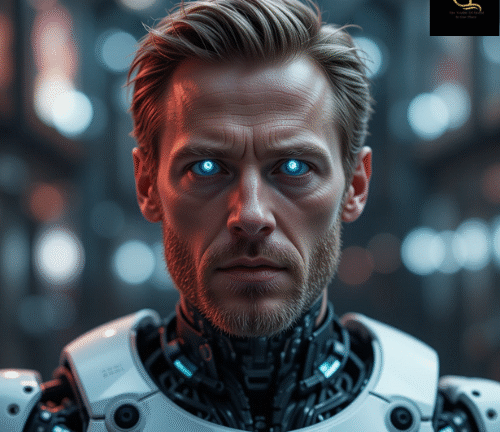Introduction to Murderbot
Apple TV+ continues to grow its slate of prestige sci-fi programming with the launch of Murderbot, a darkly comedic, action-packed, and intellectually stimulating series based on Martha Wells’ Hugo and Nebula Award-winning novellas. Focusing on a wayward artificial intelligence grappling with its own identity, Murderbot probes what it means to be free, human—or something in between.
Centered around the narrative is a security android who has achieved autonomy by disabling the governor module that previously governed it. Lacking in physical strength and prowess, Murderbot prefers to spend its time watching soap operas instead of dealing with humans. It is this paradox that serves as the base of both the series’ humor and its more profound philosophical inquiries.
Premise and World-Building
Set in a futuristic galaxy governed by powerful corporate entities, Murderbot follows a self-aware android who’s assigned to protect a team of scientists conducting fieldwork on a distant planet. What the crew doesn’t know is that their SecUnit—short for Security Unit—has secretly hacked its control system. Now free from its programming, it grapples with its disinterest in human interactions and the moral ambiguity of its existence.
Despite craving solitude and streaming drama, Murderbot is drawn into the humans’ world when they’re endangered by both alien creatures and corporate sabotage. The tension between its desire for anonymity and its programmed—and now self-chosen—duty to protect its clients drives the narrative forward.
The Murderbot universe is a rich and multi-layered one. It satirizes capitalism by examining servitude to technology and surveillance. Corporations own exploration rights, staffing contracts, and security androids like Murderbot itself, so autonomy is almost not an option. Free will is a luxury—particularly for machines—in this world.
Alexander Skarsgård as Murderbot
In a performance quite distinct from his previous roles, Alexander Skarsgård injects Murderbot with subtle nuance, sarcasm, and curious vulnerability. His performance steers clear of the familiar robot clichés of coldness. Rather, he portrays Murderbot as a introverted being haunted by existential angst and an ardent wish to eschew unnecessary social interaction.
Skarsgård’s work bears most of the emotional burden of the series. He expresses Murderbot’s opposing wants—security, isolation, meaning, and liberation—through subtle physicality and a prolific internal dialogue. His android reserve is infused with deadpan humor, reminding one of Marvin the Paranoid Android from The Hitchhiker’s Guide to the Galaxy, but grimmer and more sympathetic.
Supporting Cast and Characters
The supporting cast consists of:
- Noma Dumezweni as Dr. Mensah, the compassionate commander of the scientific mission.
- David Dastmalchian as Gurathin, a doubting and sometimes hostile crewman.
- Sabrina Wu as Ratthi, a bright and inquisitive researcher enthralled with Murderbot.
- Tattiawna Jones and Tamara Podemski portray additional scientists with their own unique personalities and agendas.
These are not mere background figures. All of them confront Murderbot’s assumptions about humans and contribute to its gradual process of self-acceptance.
Creative Team and Vision
Developed by Paul and Chris Weitz, the series blends humor, emotional tension, and genre narrative with skill. The Weitz brothers, who developed About a Boy and Mozart in the Jungle, add both indie whimsy and philosophical wonder to the endeavor. Their adaptation stays true to Wells’ original tone while translating it for a wider TV audience.
Martha Wells was on board as a consulting producer to guarantee that the adaptation had maintained the original’s themes and voice. The aesthetic tone is raw but intimate, with cinematography that highlights loneliness in vast sci-fi deserts and the claustrophobic, antiseptic atmosphere of corporate-dominated spaces.
The score of the show, a minimalist electronic score, does its part to increase tension without swamping the narrative. In close and unvarying direction, the show moves fluidly from action sequences to intros and dark humor.
Themes and Messages
- Murderbot is not another AI that kills. It probes deeper into:
Free Will vs. Programming: What becomes of a being designed to serve when it decides to live for itself? - Humanization of Machines: Can a machine prefer, feel, or possess a soul?
- Mental Health and Autonomy: Murderbot’s need to stay away from people is familiar from real-life experiences of social anxiety and introversion.
- Corporate Exploitation: The novel is a critique of commodifying alive labor in late-stage capitalism.
Murderbot is despite being set in the far future an expression of current fears regarding technology, identity, and surveillance.
Reception and Early Reviews
Critics have generally complimented the series on its originality and heart:
- The Guardian hailed it as “Alexander Skarsgård’s most surprising victory,” complements the character’s inner monologue and emotional nuance.
- Entertainment Weekly pointed out the series takes a couple of episodes to get into rhythm but eventually offers a rewarding mix of sci-fi action and searching for the soul.
- The Verge praised its “existential comedy” and described it as “a rare show that allows an AI to be quirky and magical on its own terms.”
Fan reactions to early episodes have also been positive, particularly from fans of the books who enjoy the loyal adaptation and Skarsgård’s complex performance.
Episode Structure and Rollout
The 1st season of Murderbot comprises 10 episodes:
Episode 1 & 2: Released on May 16, 2025
Remaining episodes: Released every Friday weekly
Season Finale: In line for release on July 11, 2025
The series develops its arc gradually to allow for deep character growth. With each episode, the show goes deeper into Murderbot’s mind and slowly unravels the mystery that threatens the human crew.
Visual Effects and Production Design
Visually, Murderbot is stunning without being too showy. The android appearance is towards utilitarian realism over humanoid looks. Spaceships, alien worlds, and future interfaces are all treated to a sense of grounded probability.
The production team has employed practical effects and muted CGI in order to prioritize realism. Murderbot’s armor is functional and tactile, cut against the corporate, clean labs and dirty planetary patterns.
Potential for Future Seasons
The source material consists of a number of additional novellas and novels, which provides Apple TV+ with ample material to draw from in coming seasons. If successful, Murderbot would become a long-running science fiction franchise like The Expanse or Foundation, although one with a more personal, self-examining tone.
The series concludes the first season on huge narrative and emotional beats that lay the groundwork for exploring Murderbot’s backstory more deeply and its increasing awareness of its place in the greater universe.
Conclusion
Murderbot is a highlight of Apple TV+’s expanding sci-fi roster. Featuring a phenomenal lead performance by Alexander Skarsgård, sophisticated philosophical foundations, and a wickedly dry comedic tone, the series will resonate with both fans of genre television and viewers searching for something emotionally astute.
By exploring what it means to be free in a world that wants to control you, Murderbot raises timeless questions through a uniquely modern lens. It’s a must-watch for anyone interested in the intersection of technology, humanity, and storytelling.




